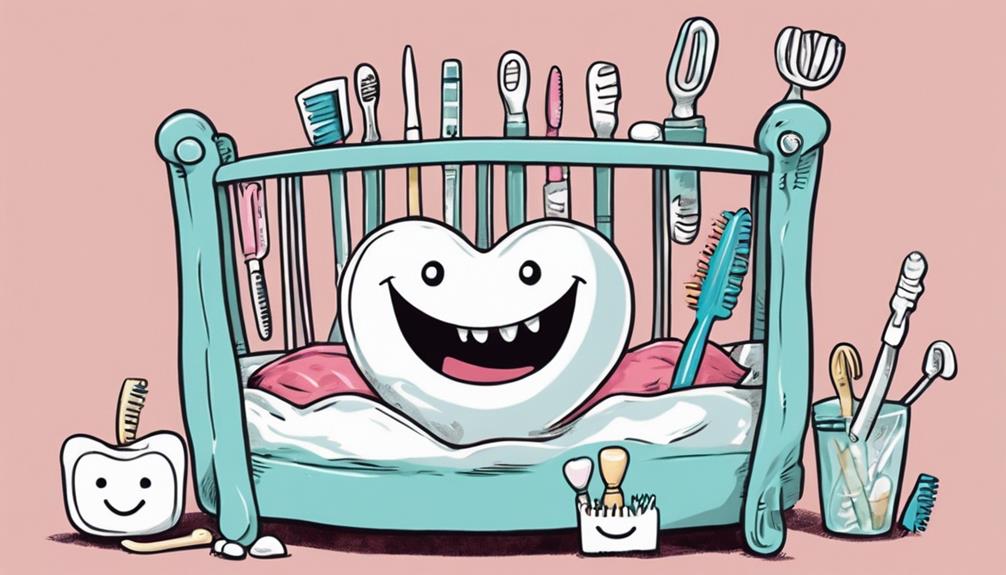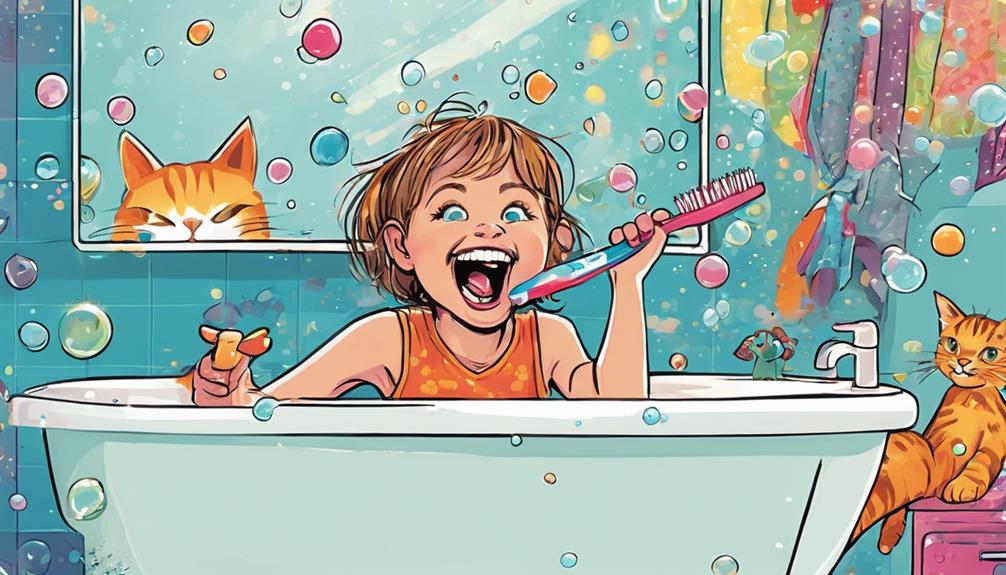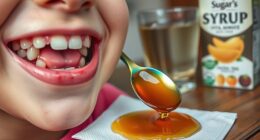Baby teeth, or primary teeth, are the first set of teeth that emerge in your child, starting around six months old, with a total of 20 by age three. These teeth play a vital role in speech development and help your child chew food effectively. They also hold space for the permanent teeth to come in properly. You'll notice teething signs like swollen gums and irritability as these teeth begin to erupt. It's important to establish a good dental care routine early on, ensuring healthy development. If you're curious about the tooth eruption timeline or common issues, there's more to explore! To support your child’s dental health, regular check-ups with a pediatric dentist are essential. It’s also helpful to educate yourself about the proper care and development of your child’s baby teeth. You may want to consider reading a baby teeth book review to find a helpful guide. Understanding the importance of their baby teeth will set your child up for a lifetime of good oral hygiene habits.
Key Takeaways
- Baby teeth, also known as primary teeth, are the first set of teeth that emerge in infants, usually starting around 6 months of age.
- A complete set of 20 baby teeth typically appears by age 3, following a predictable eruption order.
- These teeth play crucial roles in speech development, chewing, and maintaining space for permanent teeth.
- Regular dental check-ups are vital for monitoring the growth and health of baby teeth.
Overview of Baby Teeth

Baby teeth, or primary teeth, are vital for your child's development, starting to emerge around 6 months of age and totaling 20 by age 3. These teeth play a significant role in various aspects of your child's early life, including speech development and chewing. As the first set of teeth, they help create the necessary space for permanent teeth, ensuring proper alignment and overall dental health later on.
Tooth eruption begins with the lower central incisors and follows a predictable pattern, but individual timelines can vary. Your child will likely experience teething discomfort as these baby teeth push through the gums, which can be challenging for both you and them. Understanding this process can help you provide comfort and care during this phase.
Maintaining your child's dental health during the teething stage is important. Regular dental check-ups can help monitor the growth and development of primary teeth, addressing any potential issues early on.
Timeline of Eruption

When it comes to the timeline of eruption, you'll notice that baby teeth come in phases, starting around 6 months old.
However, each child's experience can vary greatly, with some showing signs of teething earlier or later than others.
Understanding these phases and variations can help you recognize the signs when your little one's teeth begin to emerge.
Eruption Phases Overview
Beginning around 6 months of age, primary teeth erupt in a specific sequence, starting with the lower central incisors. This initial eruption marks an exciting milestone in your baby's development.
Typically, the first tooth appears between 4 to 12 months, with girls often teething earlier than boys. Following the lower central incisors, the upper central incisors emerge, followed by the lateral incisors, first molars, canines, and finally, the second molars. By age 3, your baby will usually have a complete set of 20 primary teeth.
The order of eruption is important because it helps guarantee your child's oral development progresses smoothly. As your child grows, these primary teeth will eventually begin to exfoliate around ages 6 to 7.
Curiously, the order of loss mirrors that of eruption, making room for permanent teeth. By the time your child reaches age 21, they should have a complete set of 32 permanent teeth, including wisdom teeth, after losing all their primary teeth.
Understanding this timeline of eruption helps you track your baby's dental health and development effectively.
Individual Variations Explained
Eruption times for primary teeth can vary widely among children, with some starting as early as 3 months while others may not see their first tooth until after their first birthday.
Typically, central incisors are the first to appear, usually between 6 to 10 months. Following them, lateral incisors, first molars, canines, and second molars develop in order. By age 3, your child will likely have a complete set of 20 primary teeth, which are vital for chewing, speaking, and preserving space for adult teeth.
Individual variations in tooth eruption can be influenced by several factors, including genetics, gender, and overall health.
For instance, baby girls often begin teething before baby boys. It's also important to note that some children may experience delays in tooth eruption due to conditions like cleft lip and palate or other developmental anomalies.
These factors can contribute to teething pain and discomfort. As a result, monitoring your child's dental health from an early age is essential to guarantee proper development and address any potential issues.
Understanding these variations helps you prepare for the unique timeline of your child's tooth eruption journey.
Signs of Eruption
You'll likely notice several signs indicating your baby's teeth are about to erupt, often starting around 6 months of age. The first tooth usually appears between 6 to 10 months, and during this period, you'll observe various teething symptoms. Swollen gums, irritability, and mild fever can signal that teeth are about to break through the surface. These signs and symptoms can last about 48 hours, making your baby uncomfortable.
As teeth erupt, the order typically follows a pattern: central incisors first, then lateral incisors, followed by first molars, canines, and second molars. You'll see your baby's tooth development unfold gradually, with each tooth bringing new challenges and joys. Individual timelines can vary, so while some babies may get their first tooth as early as 3 months, others mightn't see one until they're a year old.
Pay close attention to your baby's cues. If you notice excessive drooling, a desire to chew on objects, or changes in sleep patterns, these might be signs that teeth are on the way. Understanding these signs can help you better support your little one during this exciting phase of growth.
Signs of Teething
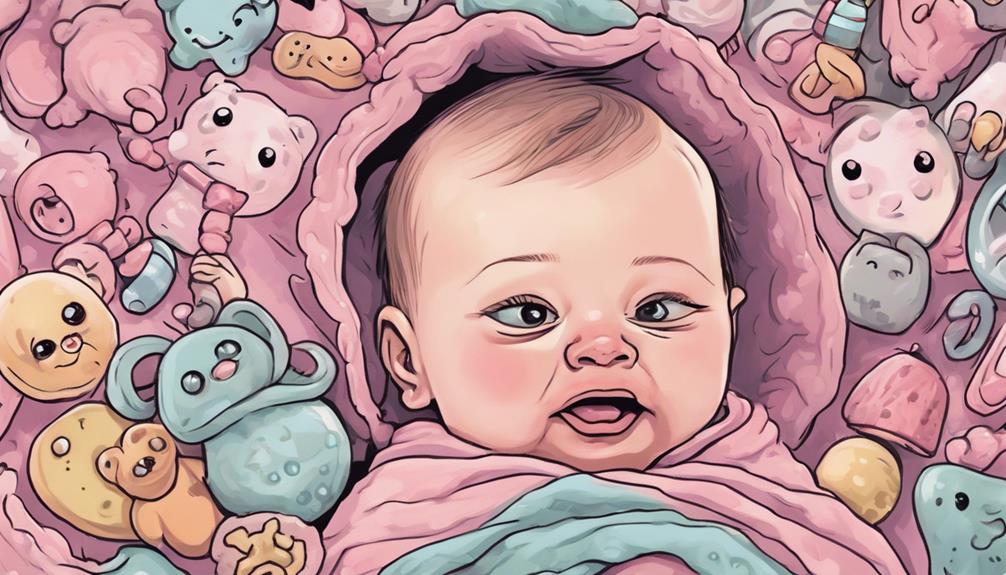
Teething can bring several noticeable signs in infants, including increased drooling, mild fever, and swollen gums as their teeth start to break through. You might notice your baby becoming fussier or irritable, which can lead to changes in their sleeping patterns. These symptoms of teething often indicate that their first teeth are on the way.
As your little one experiences teething discomfort, they may chew on objects or their fingers in search of relief. This behavior is a natural response to the pressure of erupting teeth. Keep an eye out for these signs of teething, as they typically last around 48 hours.
While mild fever (less than 102°F) is common, you should monitor your baby for any severe discomfort or prolonged symptoms that might need medical attention.
To help soothe your baby, you can use teething gels, which may provide temporary relief. However, remember that each infant is different; not all babies will exhibit the same symptoms or to the same degree.
Being attentive to your baby's needs during this phase can help make the teething process a bit easier for both of you.
Order of Tooth Eruption
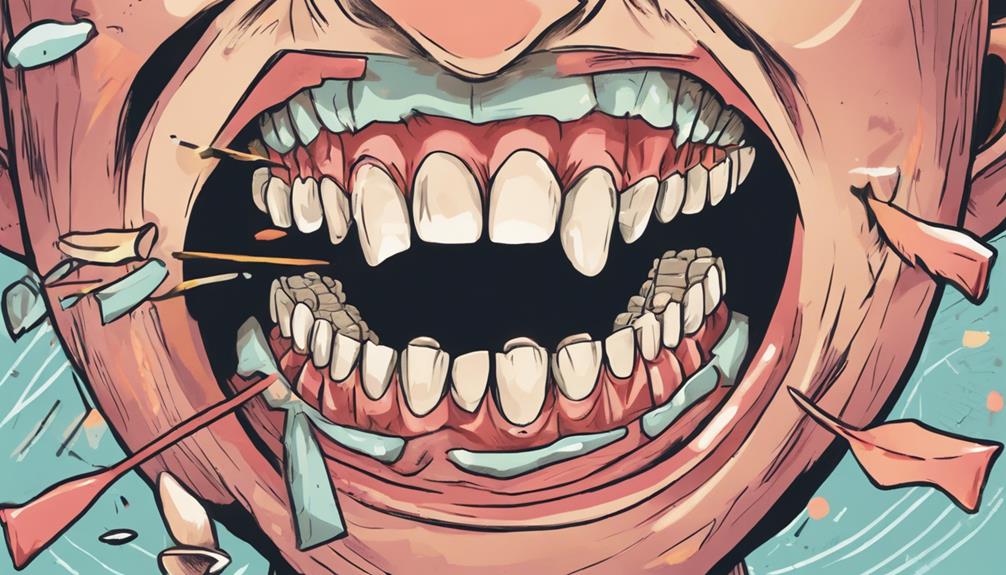
When it comes to your child's dental development, understanding the order of tooth eruption is essential.
You'll notice that the first teeth to come in are usually the lower central incisors, followed by the upper ones, and this sequence can vary from child to child.
Knowing the typical timeline and factors that influence eruption can help you track your little one's progress effectively.
Typical Eruption Timeline
Typically, baby teeth erupt in a specific order, starting with the lower central incisors around 6 to 10 months of age. These are the first teeth to make their appearance, marking the beginning of your child's journey to having a complete set of primary teeth.
After the lower central incisors, you'll notice the upper central incisors coming in between 8 to 12 months.
As your little one grows, the lateral incisors typically emerge around 9 to 13 months. Following those, you can expect the first molars to erupt between 13 to 19 months.
The canines generally come next, appearing around 16 to 22 months. Finally, the second molars will show up last, usually between 25 to 33 months.
Sequence of Eruption
Understanding the sequence of tooth eruption helps you anticipate which teeth will come in next as your child grows.
Typically, the first teeth to erupt are the lower central incisors, appearing between 6 to 10 months. After these, the upper central incisors usually follow, coming in between 8 to 12 months.
Next, the lateral incisors take their turn; the lower ones erupt between 10 to 16 months, while the upper ones emerge between 9 to 13 months.
Then, the first molars typically come in between 13 to 19 months, followed by canines, which erupt between 16 to 22 months.
Factors Influencing Eruption
Several factors, including genetics, nutrition, and overall health, can greatly impact the order and timing of your child's tooth eruption. Most children start teething around 6 months, with the lower central incisors emerging first. However, the pace of tooth eruption can vary considerably. Some kids might cut their first tooth as early as 3 months, while others may not see any until around 12 months.
Genetics plays a vital role in determining when your child will get their primary teeth. If you or your partner experienced early or late tooth eruption, your child might follow suit.
Nutrition also affects timing; a balanced diet rich in vitamins and minerals supports healthy teeth development. Poor nutrition can delay or disrupt the eruption process.
Overall health is another important factor. If your child has underlying health issues, it may impact the timing of their tooth eruption.
Importance of Baby Teeth
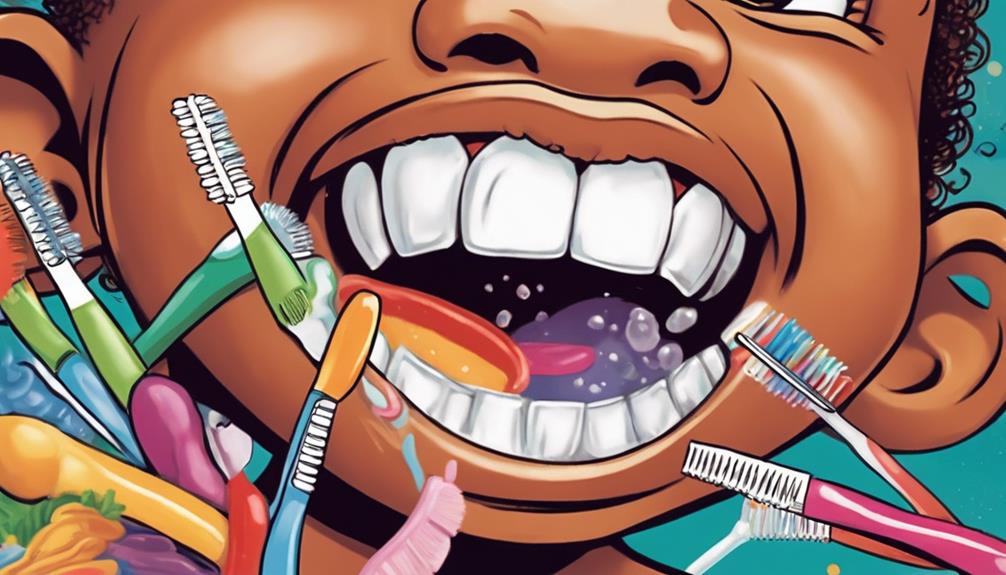
Baby teeth are essential for your child's development, impacting everything from speech to nutrition. These primary teeth, numbering 20 in total, play a significant role in proper speech development and articulation during early childhood. When kids have healthy baby teeth, they can chew effectively, which allows for a well-balanced diet necessary for growth and development.
Moreover, baby teeth serve as placeholders for permanent teeth, helping to maintain the correct spacing and alignment in the dental arch as adult teeth emerge. Their presence also influences your child's facial structure and appearance, contributing to aesthetic development and self-esteem. If baby teeth are lost too early, it can lead to alignment issues and malocclusion in permanent teeth, which can affect oral health in the long run.
Ensuring your child's baby teeth remain healthy is important for their overall child development. By prioritizing their care, you help set the foundation for strong, healthy permanent teeth in the future. Remember, those tiny teeth may seem insignificant, but they play a big role in your child's overall well-being and confidence.
Dental Care for Children
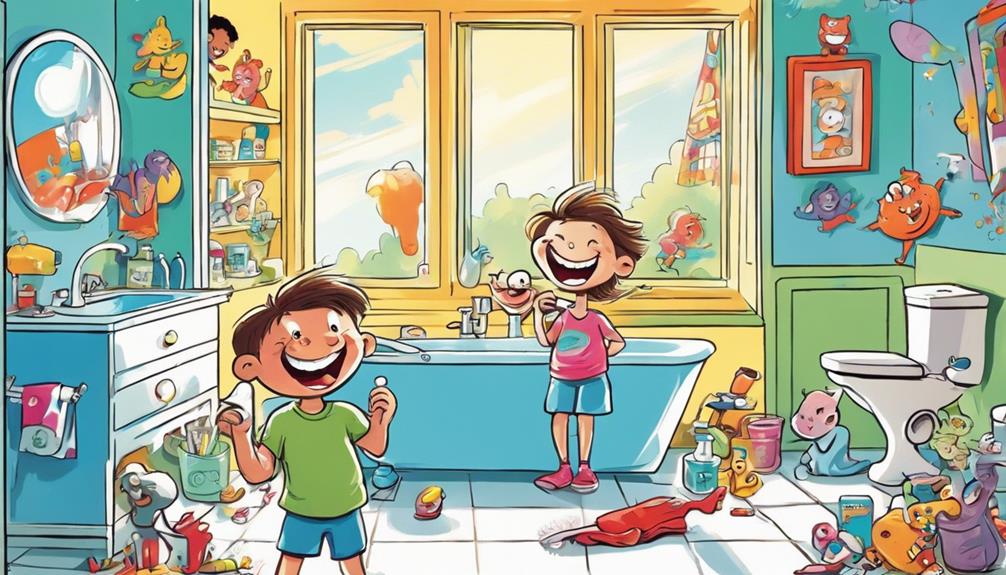
Good dental care for children starts early and lays the groundwork for a lifetime of healthy smiles. You should begin by cleaning your baby's gums with a soft cloth even before their primary teeth erupt. Establishing good oral hygiene habits from the start is vital.
Schedule your child's first dental visit by age 1 or when their first tooth appears. This allows the dentist to monitor dental development and address any concerns early on.
Once that first tooth comes in, brush it twice daily with a smear of fluoride toothpaste. As your child grows, gradually increase the amount to a pea-sized portion. Around 2.5 years of age, begin flossing to guarantee proper cleaning between teeth. This step is essential in preventing cavities and promoting oral health.
Additionally, maintain a healthy diet for your child by limiting sugary snacks and drinks. This will help prevent tooth decay and support their overall well-being.
Common Dental Issues
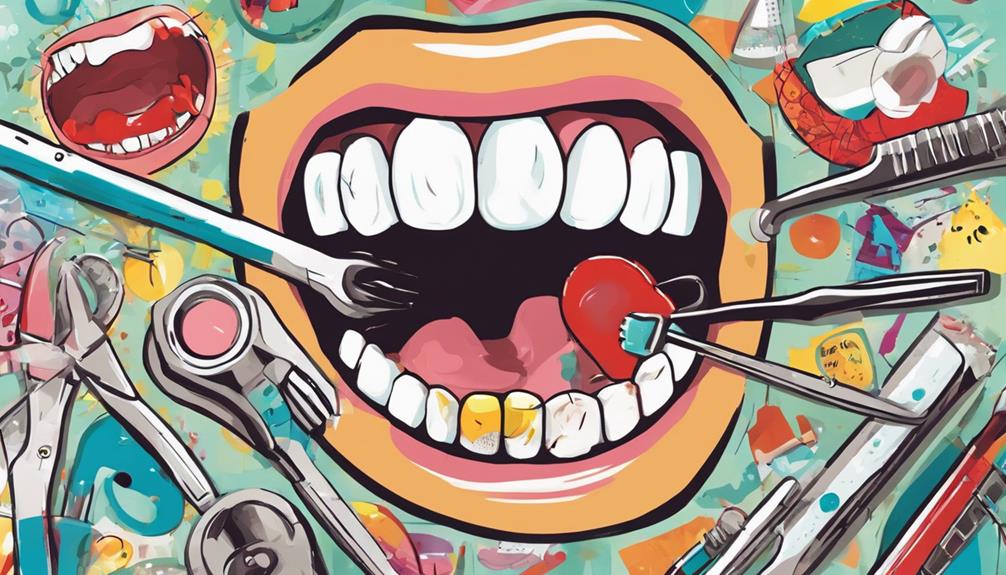
Understanding common dental issues is key to ensuring your child's oral health remains strong as they grow. One prevalent concern is cavities, which often arise from high sugar intake. If left untreated, cavities can lead to pain, infection, and more serious complications. Encouraging good oral hygiene practices, like regular brushing and flossing, can help prevent these issues.
Another issue to watch for is gingivitis, an inflammation of the gums that can occur when children neglect their oral hygiene. It can cause discomfort and lead to long-term oral health problems if not addressed.
Additionally, dental anxiety is common among kids, which might make them reluctant to visit the dentist. This anxiety can hinder effective oral health management, so finding ways to make dental visits more comfortable is essential.
Tooth loss can also be a concern, especially if baby teeth are lost prematurely. This can lead to alignment issues for permanent teeth, causing malocclusion.
Finally, habits like prolonged thumb sucking can impact dental development, resulting in misalignment and changes in jaw shape.
Primary Failure of Eruption
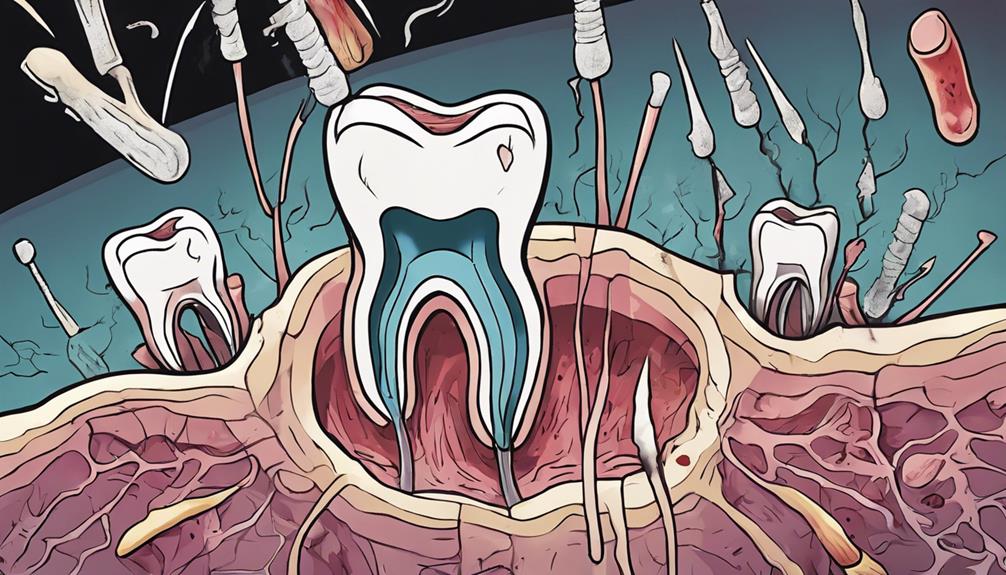
Primary Failure of Eruption (PFE) is a rare dental condition where teeth don't erupt as they should, even when there's enough space in the dental arch. This condition primarily affects primary teeth, and it can lead to issues like open bite and infra occlusion. If you notice that your child's teeth aren't erupting properly, it's important to consult a dentist for an evaluation.
PFE commonly occurs in teeth that are distal to the most mesially impacted tooth, suggesting a specific pattern in eruption failure. Genetic factors, particularly in conditions like Cleidocranial Dysplasia, can increase the likelihood of eruption failures, with many individuals showing dental anomalies.
For those experiencing PFE, early diagnosis and intervention are significant. Without timely orthodontic treatment, the complications can become more complex as permanent teeth come in.
Regular dental check-ups are critical for monitoring the eruption patterns of both primary and permanent teeth. By staying proactive, you can help guarantee that any issues related to deciduous teeth are addressed before they lead to more significant orthodontic challenges.
Teething Remedies and Care

Teething can be a challenging time for both you and your baby, but there are effective remedies and care practices that can help soothe discomfort. As your baby's primary teeth begin to erupt, it is important to prioritize their dental hygiene and comfort.
Here are some helpful teething remedies you can try:
| Teething Remedy | Description |
|---|---|
| Teething Rings | Opt for BPA-free options that can be chilled for relief. |
| Cold Washcloths | Apply a clean, cold washcloth to your baby's gums. |
| Chamomile Tea | Consult your pediatrician before introducing this natural remedy. |
Establishing an oral care routine is vital even before the first tooth appears. Gently clean your baby's gums with a soft cloth to promote good dental hygiene. Additionally, monitor your child's diet by avoiding sugary foods that can lead to cavities, especially during this teething phase. With these strategies, you can help alleviate discomfort and lay the foundation for a lifetime of healthy smiles.
Frequently Asked Questions
What Are Considered Baby Teeth?
Baby teeth, or primary teeth, are the first set of teeth you have. They typically include 20 teeth that emerge between 6 months and 3 years, helping you chew, speak, and hold space for adult teeth. As your baby teeth start to come in, you may notice some discomfort and an increase in drooling. This is all part of the teething process. Knowing what to expect when teething can help prepare you for the potential fussiness and irritability your child may experience. It’s important to offer soothing remedies such as teething toys or chilled washcloths to help alleviate their discomfort.
Does the First Molar Fall Out?
When it comes to teeth, "Out with the old, in with the new" rings true. Yes, your first molars do fall out, usually between ages 9 and 11, making way for permanent premolars.
In What Order Do Teeth Come Out?
When teeth start to come out, you'll typically notice the lower central incisors first, followed by the upper central incisors, then lateral incisors, first molars, canines, and finally the second molars.
Why Is It Called Baby Teeth?
You might wonder why they're called baby teeth. Picture tiny, temporary pearls that emerge and eventually fall away, making room for something stronger. Their fleeting nature reflects the early stages of growth and development in children.
Conclusion
In conclusion, understanding baby teeth is essential for your child's dental health.
While some believe that baby teeth don't matter since they'll fall out, they actually play an important role in proper speech development and the alignment of permanent teeth.
Ignoring their care can lead to issues later on.
By staying informed and proactive about teething and dental hygiene, you can set your child up for a healthier smile in the future.
So, don't overlook those tiny teeth!
